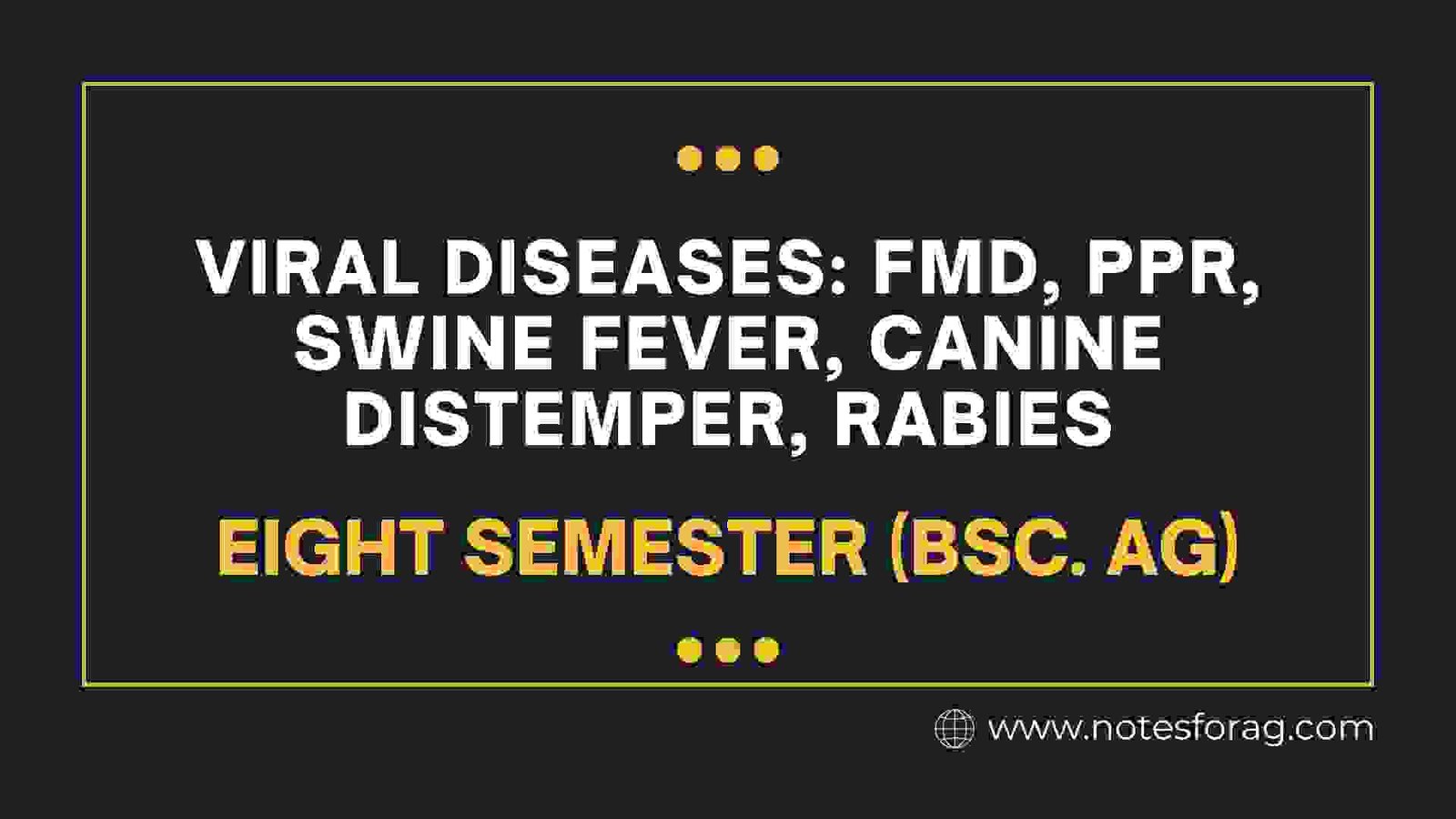Define Viral disease?

Viral diseases are caused by viruses, which are tiny organisms that can infect animals and cause illness. These diseases can spread quickly, especially in places where animals are kept close together, like farms or pet shelters.
Table of Contents
Some commmon Viral Diseases
Let’s look at some common viral diseases in animals: Foot-and-Mouth Disease (FMD), Peste des Petits Ruminants (PPR), Swine Fever, Canine Distemper, and Rabies. We’ll discuss what each disease is, how it spreads, and how to protect animals from these illnesses.
Foot-and-Mouth Disease (FMD)

Foot-and-Mouth Disease (FMD) is a viral infection that mainly affects cloven-hoofed animals like cattle, pigs, sheep, and goats. It causes fever, painful sores in the mouth, and blisters on the feet. The disease spreads easily through direct contact with infected animals or their bodily fluids, as well as through contaminated equipment and the air.
FMD can spread quickly, especially in crowded places like farms. Vaccines are available to protect animals from FMD, but once they’re infected, there’s no cure. Early detection and isolation of sick animals are important to stop the disease from spreading. In some cases, authorities may have to cull infected animals to prevent a larger outbreak.
Peste des Petits Ruminants (PPR)
Peste des Petits Ruminants (PPR) is a viral disease that affects small animals like sheep and goats. Symptoms include fever, eye and nose discharge, coughing, and sometimes diarrhea. PPR can lead to death in severe cases, especially in young animals. The virus spreads through contact with infected animals or their fluids.
PPR is a serious problem in parts of Africa, Asia, and the Middle East, where sheep and goats are important for food and income. Vaccination is the best way to protect animals from PPR. While there’s no cure once an animal is infected, good hygiene and vaccination can help prevent the disease.
Swine Fever

Swine Fever, also known as Classical Swine Fever (CSF), is a viral infection that affects pigs. It causes high fever, loss of appetite, skin discoloration, and can lead to death. The disease spreads through contact with infected pigs or their secretions, as well as through contaminated food and water.
Swine fever is a major concern for pig farmers, as it can spread quickly and cause big losses. There is no cure for swine fever, but vaccination can help prevent outbreaks. Infected animals must be isolated, and sometimes culling is necessary to stop the virus from spreading. Strict hygiene and biosecurity measures are important to prevent the disease on farms.
Canine Distemper
Canine Distemper is a viral disease that affects dogs and other animals in the dog family, such as foxes and raccoons. Symptoms include fever, coughing, eye discharge, and in severe cases, seizures. The virus spreads through contact with infected animals or their bodily fluids, such as saliva and nasal discharge.
Canine distemper is highly contagious and often spreads in places where animals are kept close together, like shelters or dog parks. Vaccination is the best way to protect dogs from distemper, and most puppies receive the vaccine as part of their routine vaccinations. There’s no cure for the disease, but supportive care can help manage the symptoms.
Rabies
Rabies is a deadly viral disease that affects the brain and nervous system. It can affect many animals, including dogs, cats, bats, and wild animals like raccoons and foxes. Rabies spreads through bites from infected animals. The virus attacks the nervous system, causing symptoms like fever, aggression, paralysis, and seizures. Once symptoms appear, rabies is almost always fatal.
Rabies is a major concern because it can spread to humans through animal bites. Vaccinating pets is the most effective way to prevent rabies. If a person is bitten by an animal that might have rabies, getting a rabies shot right away can prevent the disease. Rabies vaccination for pets and controlling wildlife populations are key to stopping the spread of the disease.
Conclusion
Viral diseases like Foot-and-Mouth Disease, Peste des Petits Ruminants, Swine Fever, Canine Distemper, and Rabies can seriously affect animals and the people who care for them. These diseases spread in different ways, such as through direct contact, contaminated surfaces, or bites from infected animals. While some diseases have vaccines to protect animals, others require strict isolation and sometimes culling to stop the spread.
To prevent these diseases, it’s important to practice good animal management, keep animals vaccinated, and maintain proper hygiene. Early detection and quick action when animals show symptoms are also key to stopping the spread of viral infections. By taking these steps, we can help keep animals safe and healthy and reduce the risk of disease outbreaks.
Frequently Asked Questions (FAQ)
What are the symptoms of Sewine Fever?
Swine Fever, or Classical Swine Fever (CSF), affects pigs and causes high fever, loss of appetite, skin discoloration, and even death. It spreads through contact with infected pigs or their secretions and through contaminated food or water.
How is Canine Distemper transmitted ?
Canine Distemper is a viral disease that affects dogs and other animals in the dog family. It spreads through contact with infected animals or their bodily fluids, such as saliva or nasal discharge. Symptoms include fever, coughing, and eye discharge, and can lead to severe neurological symptoms.
How does Rabies spread?
Rabies spreads through bites from infected animals. The virus attacks the nervous system and causes symptoms like fever, aggression, and paralysis. Rabies is almost always fatal once symptoms appear, and it can be transmitted to humans through bites.
Related Articles

